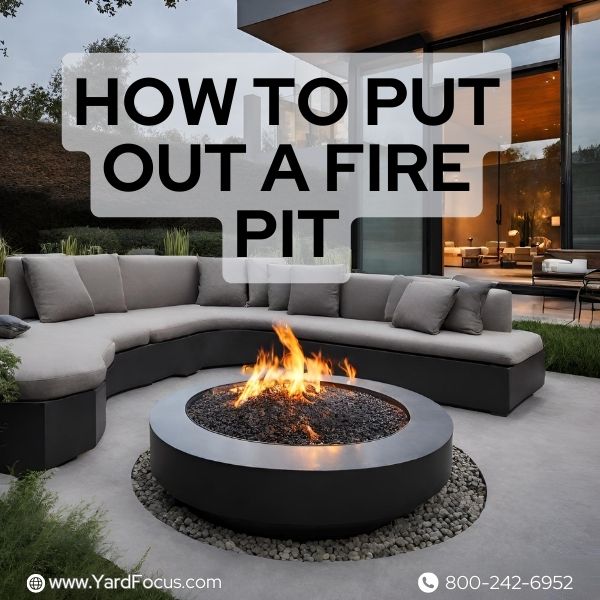
How To Put Out A Fire Pit
Gathering around a fire is great, but knowing how to put out a fire pit safely is important.
This article guides you through different ways to douse fires, fitting for all types of fire pits.
Stay safe, and read on!
Preparation for Extinguishing a Fire Pit
Before putting out your fire pit, first make sure to stop adding wood or other things that burn. Next, spread the glowing pieces apart so they cool down faster.
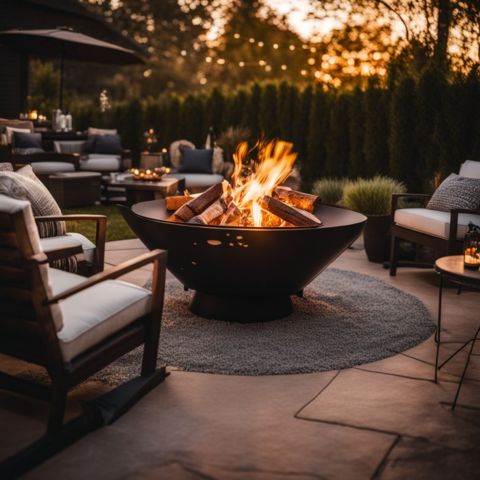
Stop Fueling the Fire
Stop adding wood or other flammable things to the fire at least an hour before you plan to leave.
This gives the fire time to burn down and makes it easier to put out later. Smaller flames are safer and quicker to deal with.
Next, spread out hot logs and coals. By doing this, you help cool them down faster. It also prepares the pit for the next steps in putting out your campfire safely.
Spread Out Hot Logs
Use fire gloves to safely handle hot logs in your wood-burning fire pits. Spread them out carefully.
This lets each log cool down faster. Have a fire blanket or sand close by to help you manage the hot logs without getting burned.
Make sure all logs are spread apart and cooling down before you leave the area.
A thorough check for stray embers is key to ensuring no hidden sparks can start a new fire.
Keep safety tools like a spark screen nearby to protect yourself and others while working with the logs.
Extinguishing Methods for Different Types of Fire Pits
Putting out fires in your backyard gathering spot needs different approaches based on what kind it is.
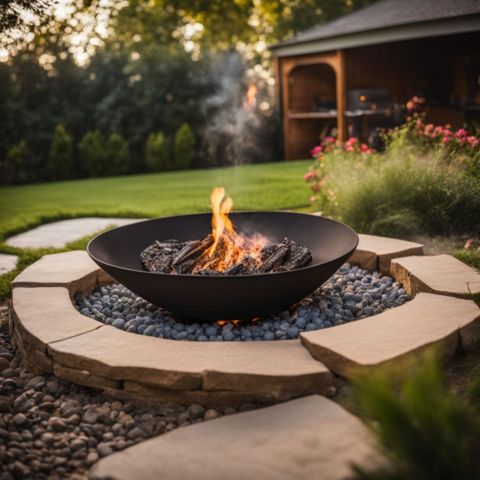
If you have a pit that uses city gas or bottled gas, you'll follow one set of steps; for those that burn logs, there's another path to safety.
Natural Gas and Propane Fire Pits
To extinguish natural gas and propane fire pits, simply turn off the fuel source.
Regularly schedule professional safety checks to ensure there are no gas leaks or hazards, especially if you notice any issues with your gas fire pit's performance.
Make sure everything is off and safe. Check if lava rocks or fire glass have cooled down before you cover the pit.
Keep your fire pit area safe from fire hazards. Use a spark screen for extra safety. Always have firefighting tools like a fire extinguisher ready, just in case.
This helps prevent fires from spreading and keeps everyone safe around the fire pit.
Wood-burning Fire Pits
Moving on from gas fire pits, wood-burning ones offer a classic experience but need careful handling to extinguish.
While using seasoned wood is recommended for a cleaner and hotter burn, ensure you have extinguishing materials like water or sand readily available for safe and efficient fire management.
There are several ways to safely douse your campfire. One can let it die naturally or drench all the embers with water.
Although covering embers with sand or earth can smother flames, it may not cool the fire as effectively as water.
Use this method with caution and ensure all embers are fully extinguished to prevent hidden fires.
You might also cover the flames with a snuffer or a flame blocker, which chokes off air and puts out the fire.
Fire safety should be a top priority to prevent wildland fires or damage to your home.
Keep combustible materials like plywood away from the pit area. Use protective gear such as spark screens and fire gloves whenever you're around open flames.
Make sure you have an emergency plan that includes having a fire extinguisher nearby in case things get out of hand.
Properly putting out your campfire ensures everyone's safety and keeps your property secure.
Techniques to Safely Extinguish Fire Pit
Putting out a fire pit safely requires the right steps and tools.
You can use different methods depending on your fire pit type, like pouring water carefully or covering it with sand or soil.
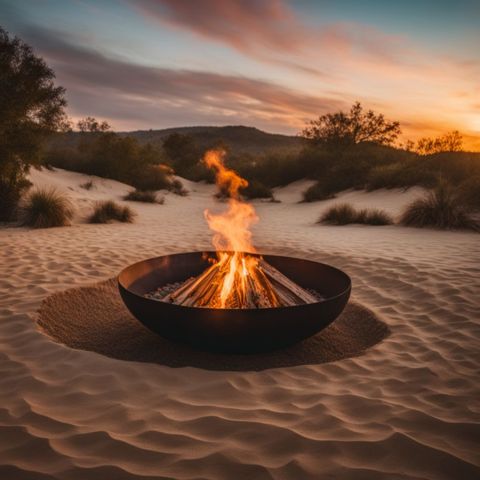
Letting Fire Die Out
To let a fire in your pit burn down, stop adding wood about an hour before you plan to leave.
This gives the flames time to use up what's already burning. As the fire gets smaller, it becomes easier to manage and put out completely.
Make sure you stay nearby as the fire reduces. Watch for any stray sparks or bits of wood that might try to escape.
Keeping an eye on everything ensures that the fire goes out safely without causing unwanted fires elsewhere.
Using Water
Pour water slowly over the fire pit to cool down hot logs and embers.
Make sure you use a garden hose with a setting that sends out a gentle spray. This helps stop sparks from flying around.
Keep pouring water until you can't hear any more hissing sounds from the fire pit. This means it's safe and fully extinguished.
Always have your emergency plan in mind when dealing with fires outdoors or near your home.
Using water is effective but requires care to prevent accidents or the spreading of sparks that could start a fire somewhere else.
Having things ready, like a multi-pattern nozzle for your hose, ensures safety while putting out the fire in your pit, protecting both people around you and extending the life of your outdoor gathering spot.
Using Sand or Dirt
If your fire pit is a fixed part of the yard and can’t be moved, dry sand or dirt is great for putting out fires.
Cover all the hot coals with it. This method smothers the flames by cutting off their air supply.
Make sure you have enough sand or soil to cover everything that’s still burning.
For wood-burning pits, spreading sand or earth over the embers works well too. Do this carefully to ensure no sparks fly out and start new fires.
Always wear gloves to protect your hands from heat, and use tools like shovels for safety.
Using sand or dirt can significantly reduce the risk of flying cinders, though it's important to remain vigilant for any stray sparks.
Sand or dirt can insulate embers, keeping them hot longer, so you'll want to occasionally check and ensure that embers have cooled before leaving the site.
Using a Snuffer
For wood-burning fire pits, a snuffer can be an effective tool by depriving the fire of oxygen.
For gas fire pits, ensure the gas supply is turned off and check for safety hazards. It works by covering the flames and cutting off their oxygen supply.
This method is safe, effective, and protects both the people around and the fire pit itself.
It's important to do regular maintenance checks on gas lines and connections to prevent leaks, which could be dangerous even when the pit is not in use.
For wood fires, lay a fire blanket over the logs to suffocate the fire.
For propane and natural gas fire pits, placing a metal lid or cap directly on top seals off gas flow and extinguishes the flames quickly.
Always ensure your hands are protected with gloves when handling a snuffer or lid due to high temperatures.
Moving on to using a fire extinguisher offers another safety measure for dealing with unexpected flare-ups.
Using a Fire Extinguisher
Another effective tool for putting out fire pits is a fire extinguisher. This device shoots out chemicals to stop fires fast.
Familiarize yourself with how to use a fire extinguisher properly before encountering a fire emergency.
Ensure you use the appropriate type of fire extinguisher for your fire pit. For wood-burning fires, water or foam extinguishers are effective, whereas CO2 or dry powder extinguishers are better suited for gas fire pits.
Point the nozzle at the base of the flames and squeeze the handle. Sweep side to side until the fire is out.
Keep your extinguisher close by whenever you have a fire going. It's good for quick action if things get out of hand.
Always check that it's fully charged and ready for use.
Fire Pit Safety Tips
Keep yourself safe by using a spark guard, heat-resistant gloves, and other protective gear.
Always have a ready-to-use fire extinguisher and first aid kit nearby.
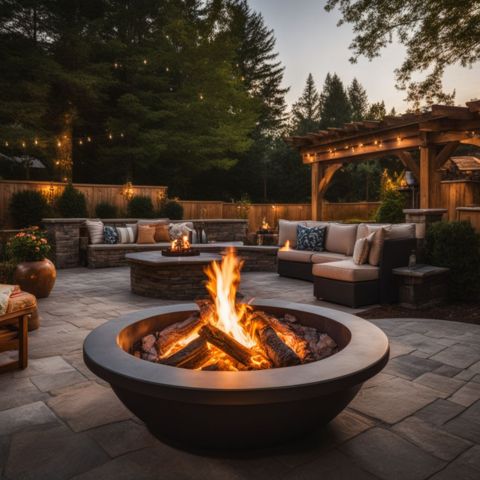
Use a Spark Screen, Fire Gloves, and Other Protective Equipment
A spark screen keeps flying embers from escaping your fire pit. These tiny sparks can light up things outside the pit if they get out. S
o, covering your fire with a screen is like putting a lid on trouble before it starts.
Fire gloves are also key for safety. They protect your hands when you handle hot logs or move the spark screen aside.
Having proper gear makes dealing with fire less risky.
This includes tools like long pokers to adjust wood safely and fire blankets in case flames spread unexpectedly.
Always wear thick protective clothing too, not just gloves, to guard against heat and sparks as you manage the blaze.
Have a Fully Charged Fire Extinguisher and First Aid Kit
Keep a full fire extinguisher and first aid kit ready. These tools are your best friends in keeping fire pit fun safe.
A working extinguisher can stop fires from getting out of hand.
Make sure it's always charged and within reach. Also, know how to use it before any fire starts.
Your first-aid kit should have items for burns and cuts.
Immediate and appropriate first aid can prevent minor injuries from worsening, emphasizing the need for a well-stocked and accessible first aid kit.
Having these safety tools is key, as highlighted by home insurance advice, emphasizing their role in preventing accidents that could lead to claims or even impact your liability coverage.
After Extinguishing Fire Pit
After you put out the fire pit, take a good look around. Make sure there are no glowing pieces of wood or coal left.
Then, clean up all the cold ash and get rid of it safely. This keeps your space tidy and ready for the next time you want to enjoy a fire.
Thorough Check for Stray Embers
Look around carefully for any stray sparks or glowing pieces after you put out the fire pit.
You need to make sure no hot bits are left that could start a new fire. Use a flashlight in dark areas to help see any hidden embers.
This step is crucial for fire prevention and keeping your home safe.
Gently stir through the ashes with a metal tool to find any warm spots that might be hiding underneath.
If you find any, douse them with water until they cool down completely. Doing this helps prevent wildfires and keeps everyone around them safe.
It's just as important as having insurance for your house because it protects against unexpected fires spreading.
Cleaning up Cooled Ashes
After putting out the fire pit, wait for the ashes to cool down. This is a key step.
Use a sufficient amount of water to thoroughly soak all embers, adjusting based on the size and heat of your fire pit.
This makes sure nothing keeps burning and helps with cleanup.
Next, scoop up the wet ashes and dispose of them safely.
When disposing of soaked ashes, ensure you do so in a manner that minimizes environmental impact, especially in regions where water conservation is crucial.
Ashes should be placed in a metal container and soaked with water or left to cool for several days before disposal.
If you don't have water, covering the embers with sand or soil can also put out any remaining heat.
Always double-check for stray sparks before leaving the area to prevent any risk of a flare-up.
FAQs
What is the safest way to put out a fire in my fire pit?
To safely put out a fire in your fire pit, spread the wood or firewood around so it cools down faster. Then, gently pour water over it until the hissing sound stops.
Can I use sand to extinguish my fireplace or fire pit flames?
Yes, you can use sand to put out fires in your fireplace or fire pit by covering the flames completely with sand, which smothers and cools the embers.
Is it okay to leave a gas stove's flame unattended, like we do with wood in a fire pit?
No, unlike wood in an outdoor fire pit, you should never leave a gas stove's flame unattended because it poses a high risk of causing fires that could lead to contacting your insurance company for property damage.
Should I inform my insurance company if I regularly use a large outdoor fireplace or fire pit at home?
Yes, informing your insurance company about using an outdoor fireplace or large fire pits is wise, as they may provide specific guidelines or requirements for safety and coverage.
Conclusion
knowing how to put out a fire pit safely keeps everyone safe and makes sure your fire pit lasts longer.
First, stop adding wood or fuel. Spread out the embers to cool faster. If it's a wood-powered one, pour water using a hose set on spray to avoid sparks flying.
For those powered by natural gas or propane, turn off the gas supply securely. Sand or soil also works well for smothering flames without water.
Snuffers are great for controlled extinguishing, too.
Always wear protective gear like gloves and use a spark screen to keep embers from spreading.
Clean up after ensuring all embers are out to prevent any risk of reigniting or causing wildfires.
These steps help protect you, others, and your property while enjoying cozy nights around the fire pit.

